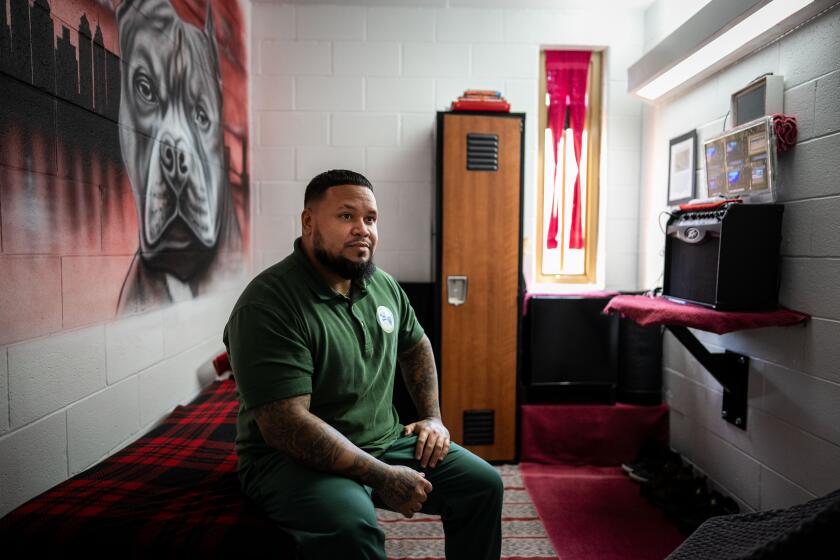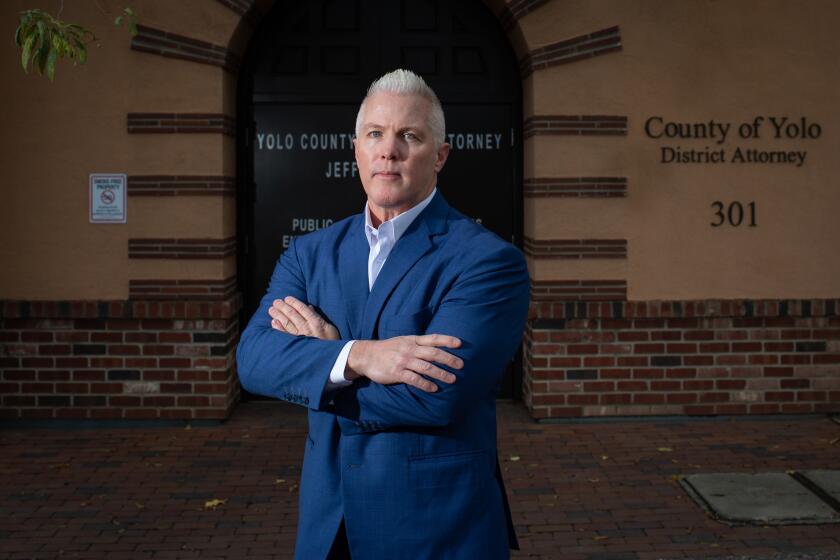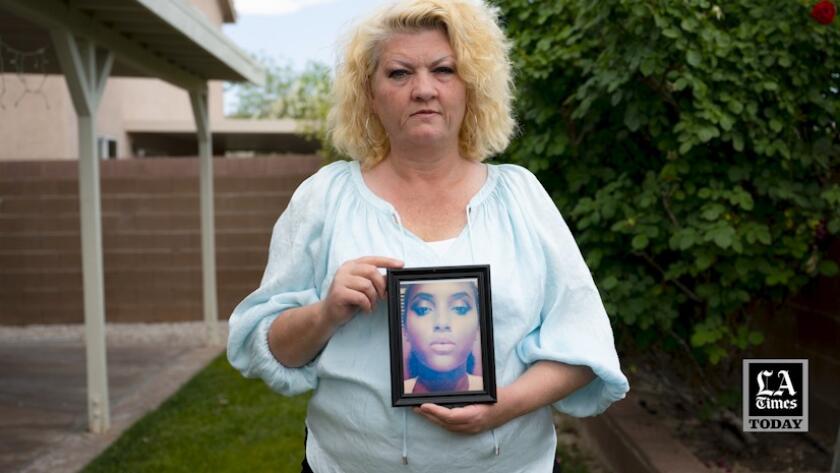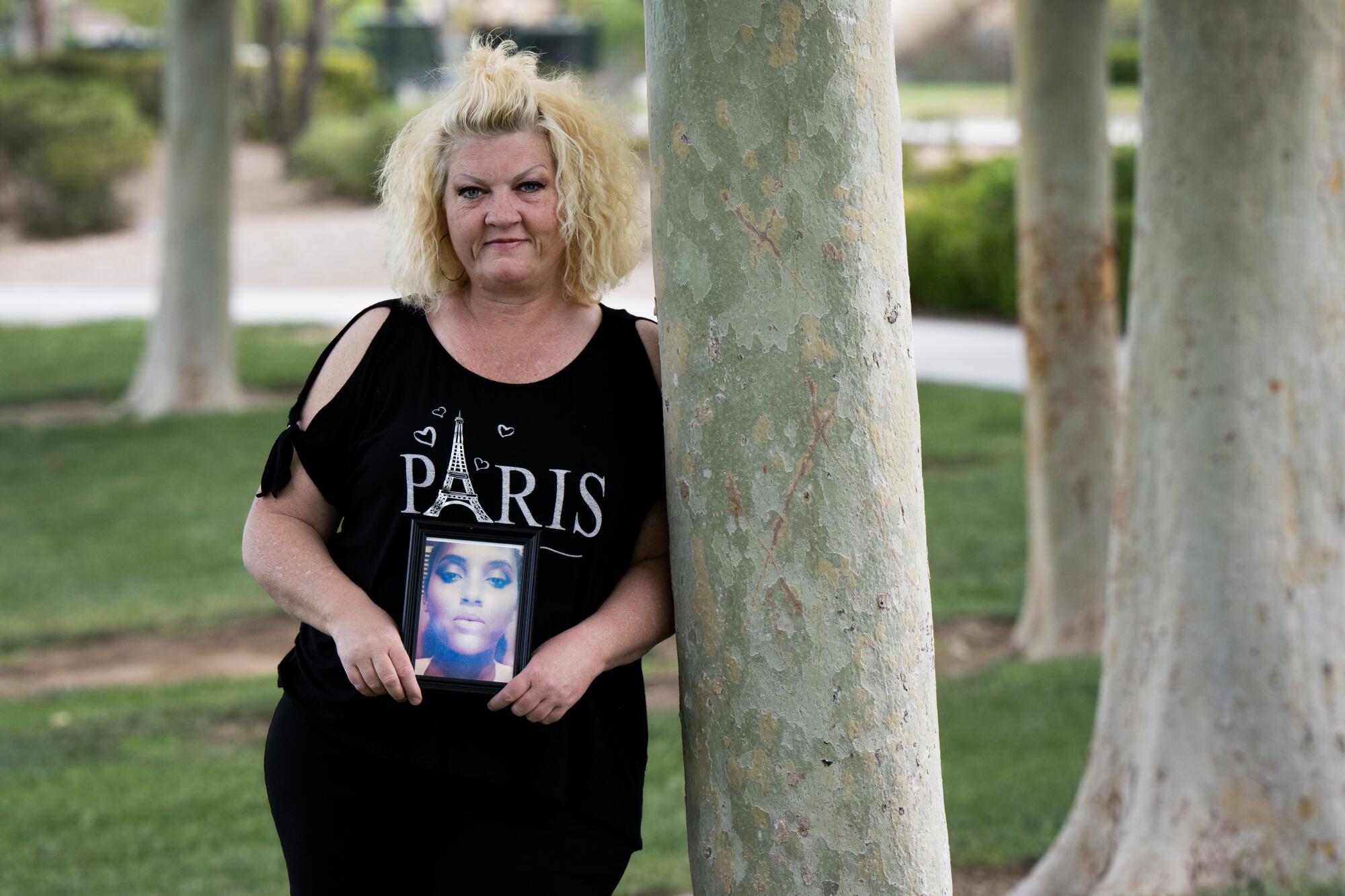
- Share via
Forgiveness is complicated. So is its counterpart, remorse.
Both require moving on from pain and violation — either as perpetrator or victim — while somehow holding space for the meaning of that suffering. Both require faith that the past doesn’t own the future.
But how do you move forward when your child is murdered — shot and discarded in the desert like a piece of trash? How do you forgive the man who did it, even if he feels remorse? How do you know the remorse is real?
Jill Harrison has spent four nightmare years living those questions, and still the answers are elusive, though the grief is not.
In the spring of 2019, just as a heat wave was hitting the Inland Empire, Harrison’s daughter Ciara Starr Harrison, 25, was murdered by Cainen Chambers, a methamphetamine addict with a felony record who had known Ciara for a little more than a month.
After what Chambers described to me as days of heavy drug use, he and Ciara argued and he shot her, he said. At least one bullet struck her in the head. There was, he said, no good reason. He just lost his temper and did it.
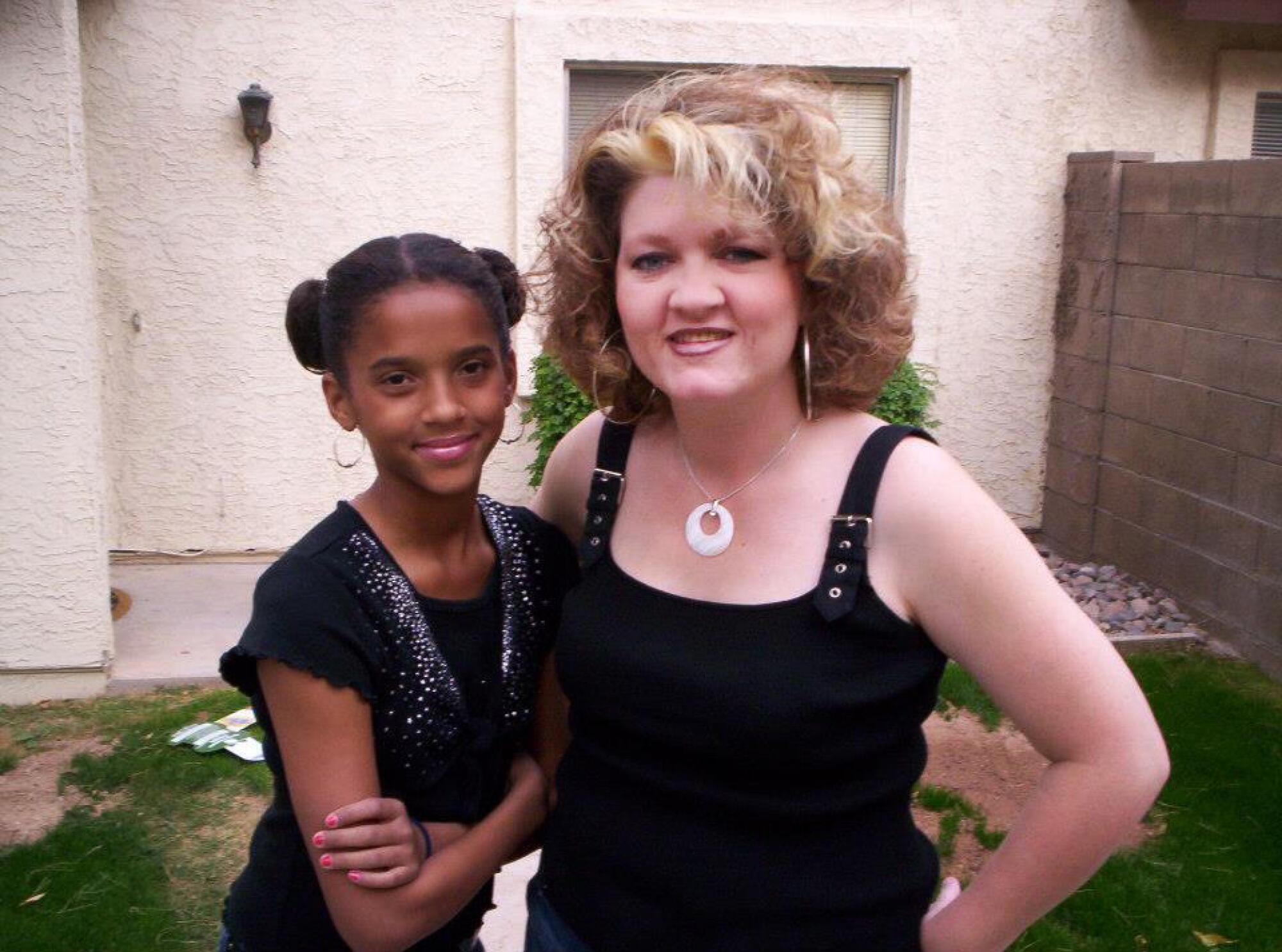
Then he drove to a dirt road in Moreno Valley, where two friends helped him dump Ciara’s body down a hillside, he later told Harrison.
Yes, Chambers and Harrison have talked. More than once.
We’ll get to that — and how this whole, sad story is really about Gov. Gavin Newsom’s important but misunderstood plan to turn San Quentin State Prison into a place where criminals, violent and otherwise, have a real chance at rehabilitation.
Gov. Gavin Newsom this week will announce plans to remake San Quentin, one of the state’s most storied prisons, using a Scandinavian prison model that emphasizes rehabilitation.
Not for some do-gooder, bleeding-heart version of justice, but because people such as Chambers will keep murdering people such as Ciara until something changes. About 45% of those released from prison are convicted of a new crime within three years, with about 21% committing a felony — recidivism numbers that have remained stubbornly high for years of political swings between tough-on-crime policies and reforms.
But first, there are things you should know about Ciara Harrison.
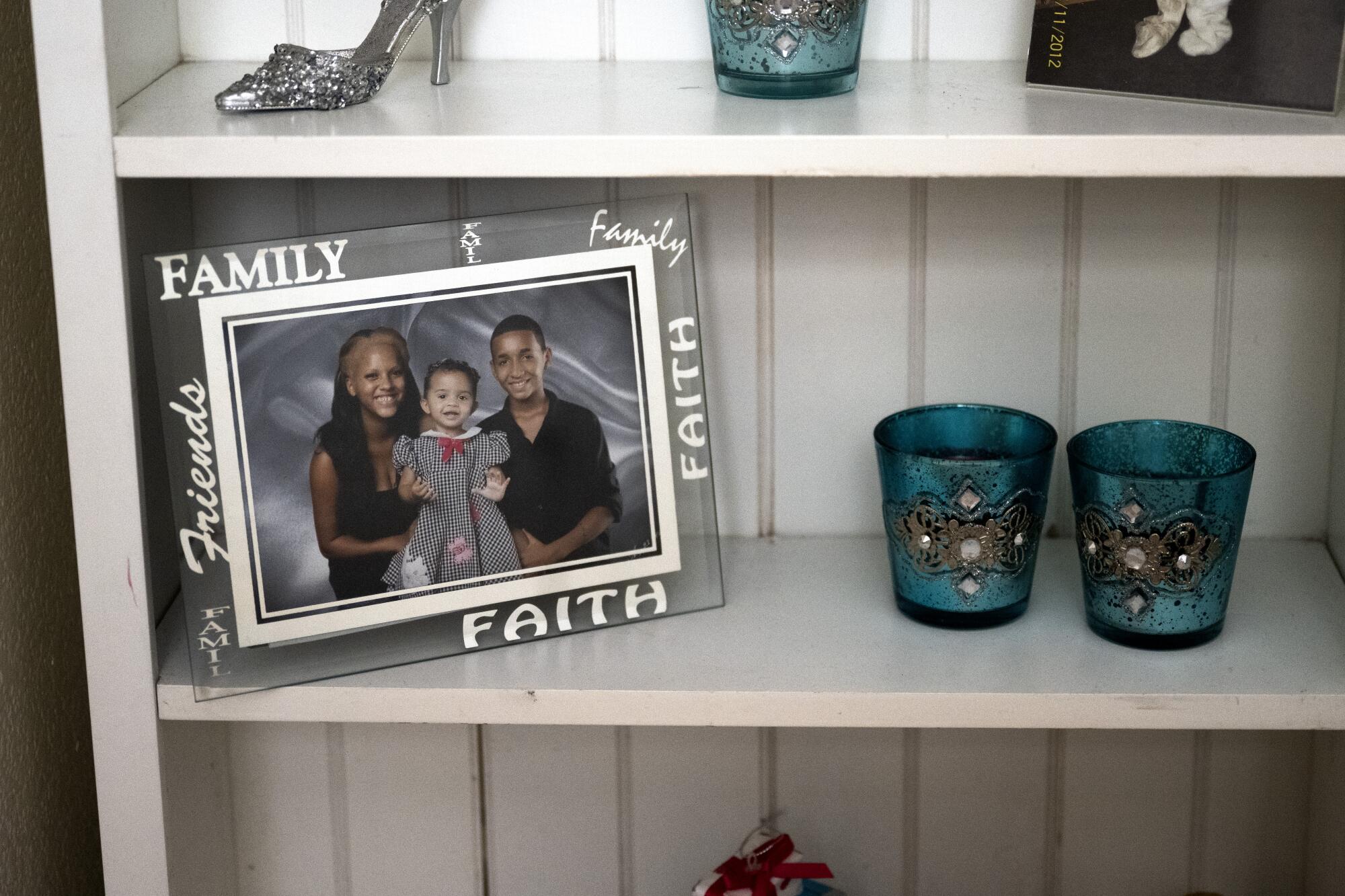
She was the mother of a 3-year-old daughter. She had almond-shaped eyes. Once, when she was about 8, Ciara sneaked into her neighbor’s garage to rescue a family of kittens that the neighbor was threatening to put down. After she died, Harrison took a story that Ciara had written about that escapade and turned it into a book, “Kittens with Sweaters,” a remembrance of the brave child who was also “bubbly” and “very animated.” A girl who loved to sing and had a voice like Rihanna, Harrison said — but who never let her mom record her.
“It really hurts me that I don’t have not one recording of her singing,” Harrison said, ache as thick as syrup weighing down her words. “She would never let me catch her; she would always stop.”
Days after Ciara was killed, a construction worker was leveling a pad for a double-wide mobile home when he saw what he thought were the legs of a dead donkey sticking out of the brush, Harrison told me. The construction worker investigated and found what was left of Ciara: a decimated body eaten to the bone in some places, her hair sloughed off and stuck in a nearby bush.
“I went to bed every night just sobbing because my baby lay out there for 11 days, all day in the heat, and all night with bugs on her, all by herself and alone,” Harrison said.
Sign up for This Evening's Big Stories
Catch up on the day with the 7 biggest L.A. Times stories in your inbox every weekday evening.
You may occasionally receive promotional content from the Los Angeles Times.
Harrison’s loss exploded into a need to know, anything, everything. When police couldn’t or wouldn’t give her the answers, she started investigating herself, though she was hundreds of miles away in Utah.
She tracked down that construction worker. She joined the buy-sell-trade online message boards for the area where Ciara had lived, and begged people for information — moms selling leftover diapers, men hawking decades-old cars, anyone who would listen. People warned her it was dangerous; the cops told her to back off.
But she couldn’t. She called Texas State University’s Forensic Anthropology Research Facility — better known as a body farm, where human decomposition is studied by burying corpses — and made some poor soul explain to her what the larvae in Ciara’s body meant, how long she had been a feast for insects. She became obsessed with finding the killer.
“I obviously wanted massive revenge,” she told me.
But what she didn’t know was that the killer was already in jail. Chambers had been incarcerated in a county facility since the day before Ciara’s body was discovered — arrested on unrelated charges of child endangerment and false imprisonment, according to court records — more alleged crimes in a long list of misdemeanors and felonies that pointed to a bleak and unrepentant existence.
In December 2019, Chambers was charged with Ciara’s death and his arraignment set for a few days before Christmas. Authorities told Harrison not to bother coming — that it would just be a quick formality.
But this arrest was different for Chambers.
In biblical terms, the name Cainen can mean to be brought down by a heavy load, and that’s how he was feeling.
“Life, it had boiled over,” he told me recently, speaking from San Quentin, where he is incarcerated. “I was too far underwater, and I just had to surrender to God and to, you know, what is right.”
Chambers was tired of running from himself, he said. Tired of the drugs. Tired of being in pain and inflicting pain.
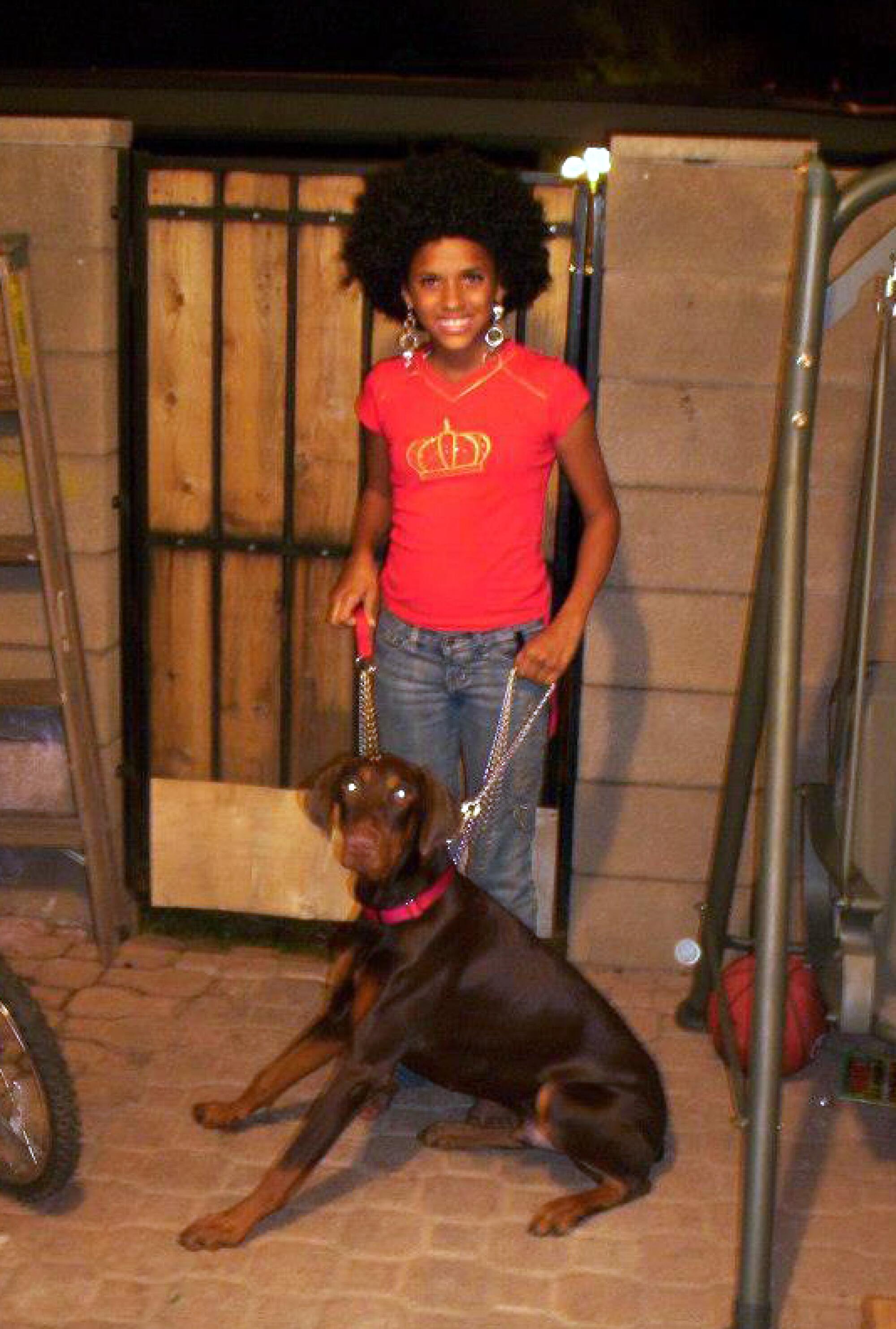
“For me, killing someone was the scariest thing that has ever happened in my life,” he said.
On the day of his court appearance, Chambers confessed to murdering Ciara Harrison.
He told the judge he was guilty and wanted to be sentenced immediately. The district attorney scrambled to get Harrison on the phone so she could make a victim’s statement. The judge gave Chambers 50 years to life for first-degree murder, and in a few minutes, it was over.
“I don’t have a whole portfolio full of doing the right things,” Chambers told me. “So doing the right thing to me felt really good.”
After he left the courtroom, one of the sheriff’s deputies shook his hand, telling him, “Great job,” for owning his actions.
But that endorphin high wore off, and Chambers was still facing the real possibility of dying an old man in prison, he said.
He thought about suicide.
Then a letter arrived from Harrison, telling him she too was proud of him for confessing. And again, he said, something inside him saw the possibility of a different life, even behind bars.
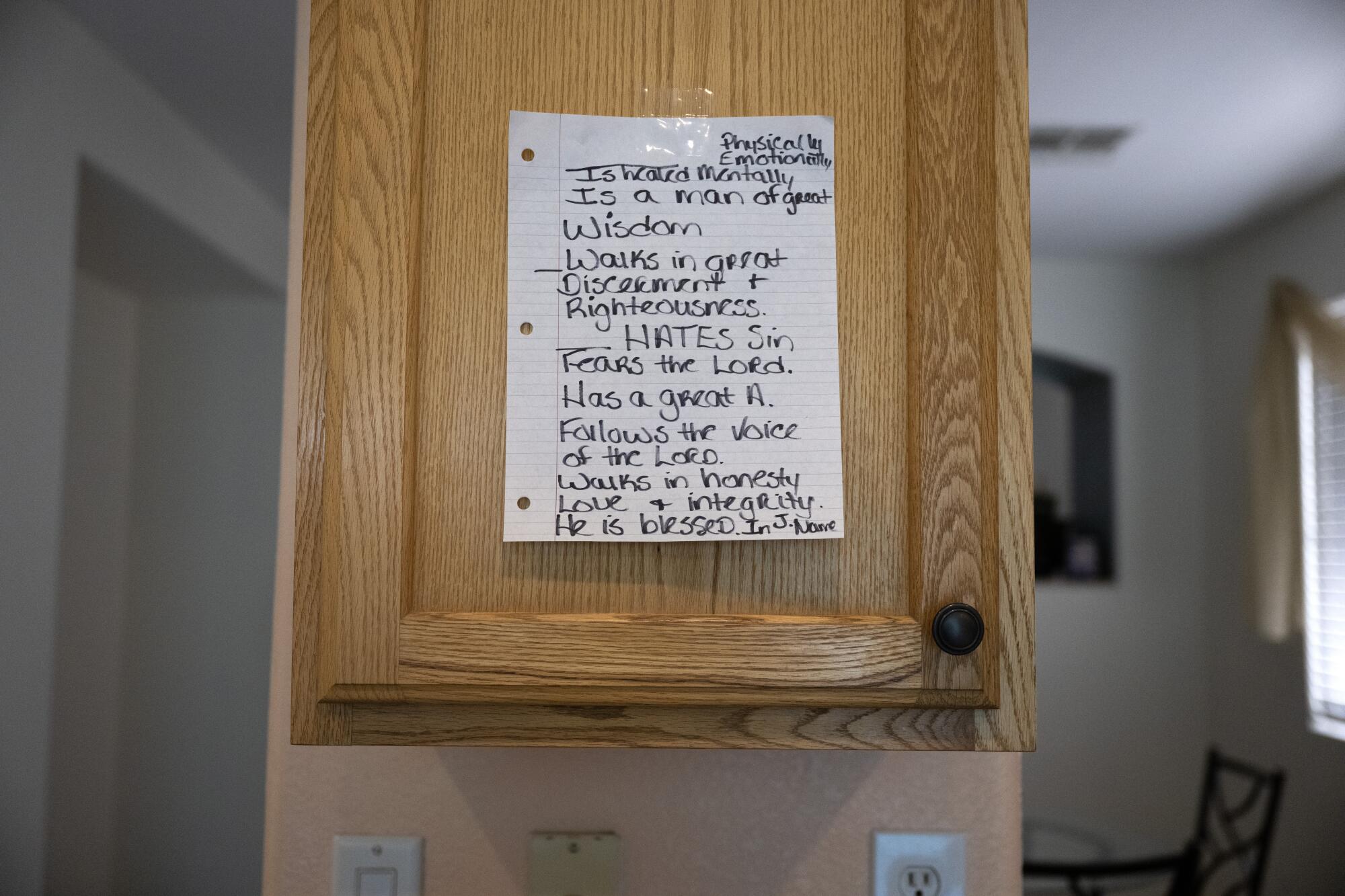
“It just felt like when I read this letter, that God and society was willing to give me a second chance,” he told me. “I may be delusional, but at least it’s a good thought.”
For Harrison, the letter was more of an ask than an offering. Her need to know had not diminished, and she wanted more than a confession. She wanted Chambers to talk to her.
The fancy name for what Harrison was after is restorative justice. But for her, in the isolation of grief, communicating with Chambers seemed like the only way forward, the only way to find the answers she thought would bring her understanding, if not peace. Even if no one else understood her need.

Subscribers get exclusive access to this story
We’re offering L.A. Times subscribers special access to our best journalism. Thank you for your support.
Explore more Subscriber Exclusive content.
Harrison remembers her “stomach hit the floor” when the prison number popped up on her phone. She had watched so many of Chambers’ social media videos that his voice was instantly familiar.
She yelled, cried, told him the details that hurt her most — that Ciara was so decomposed she had to be cremated.
“I said, ‘The thing is, I didn’t just lose my child. You destroyed her body. Like, through the process of your choices. I got pieces,’” Harrison said.
“I said, ‘Cainen, man, there were days to console myself, I had to think, well, at least she wasn’t raped, and then cut into pieces with a chainsaw. Well, at least she wasn’t raped and set on fire. So that’s good.’”
But even through that rage, for months Harrison had been hearing a voice telling her to forgive Chambers. Standing at her kitchen sink doing dishes, she’d fantasize about torturing him, and the voice would pop up deep inside her psyche.
This is the person you want to be? it asked. Buried in bitterness, trapped by hate that eats you from the inside out?
Forget it, she told the voice. I want him to hurt.
Really? the voice shot back, again and again.
“And then I made a decision that I couldn’t get Ciara back,” Harrison told me. “And so to turn this tragedy around, I wanted not only to heal forward and for my friends and family to heal forward, but I wanted her life to be a seed that’s planted that bears much fruit.”
If Cainen Chambers became not just a better man, but a different man, maybe that was Ciara’s legacy, Harrison said.
Through gritted teeth, she began to say it out loud: I forgive Cainen Chambers.
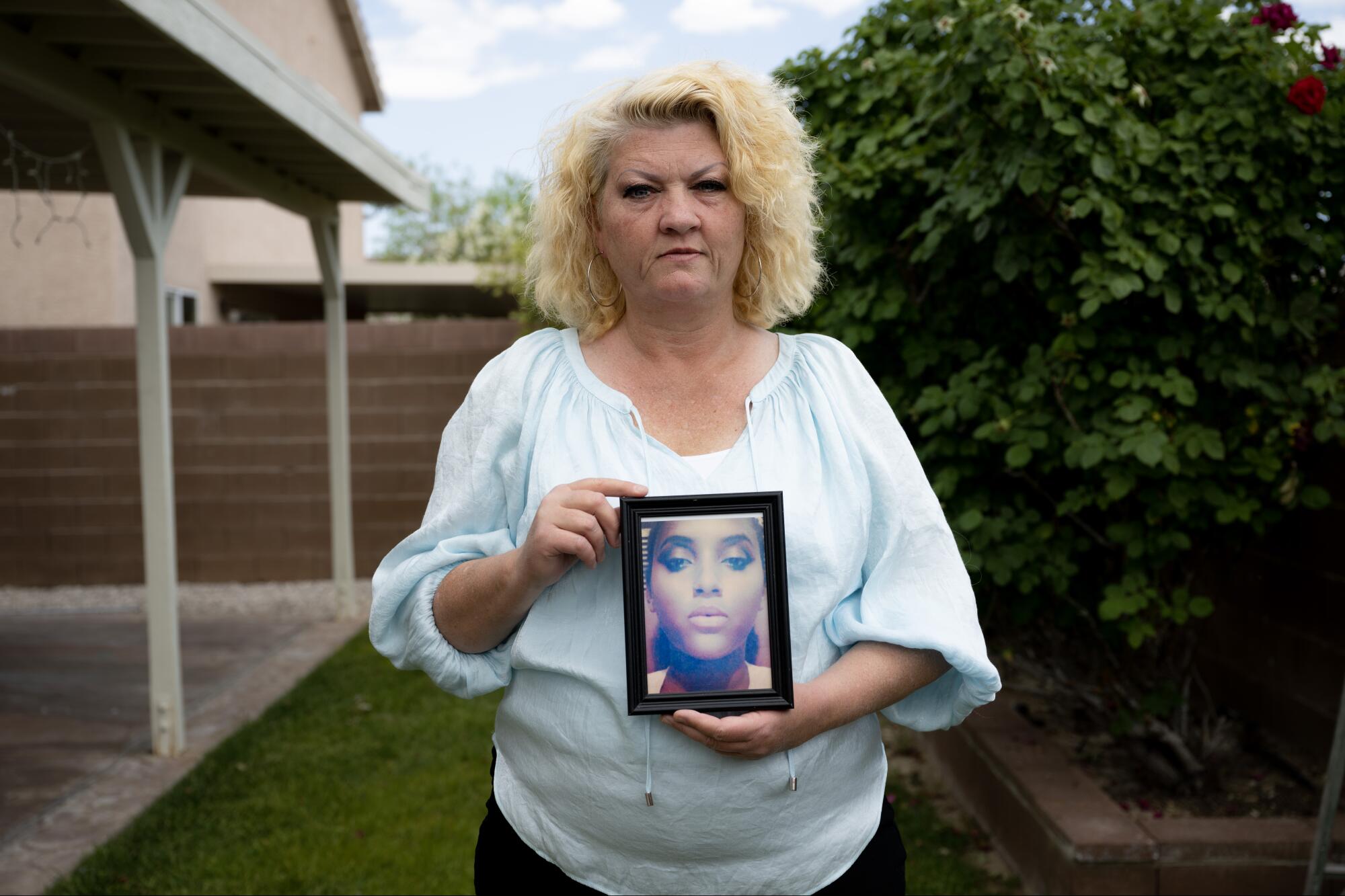
But she needed Chambers to go beyond remorse.
Because like forgiveness, remorse isn’t a moment, an apology that stales as soon as it’s spoken. It’s a daily ritual, a commitment. A faith that the past does not own the future.
“Get on your face before God and you repent, and you dig deep, and you take whatever classes you can, you read whatever you can, you get to the bottom of how you got here,” she told Chambers. “And you go through a metamorphosis, and you change who you’ve been into who you should have been, and then you show others how to do that. Because that’s going to turn this dark, horrific, evil thing around and bring good.”
Chambers seems to want that change. In the four years that he’s been incarcerated, he has been a model prisoner. He has taken classes, stayed out of trouble and works on San Quentin’s highly respected newspaper.
Most important, to Harrison, and to Chambers, he is working to figure out why he is who he is.
Like Ciara, Chambers is mixed-race, Black and white. He told me his white grandmother was “an alcoholic, and she was racist,” and it affected him deeply.
“I always struggled with my Blackness, my identity,” he told me. “I was the good child. And I always excelled at school. But by the time I got old enough to understand what was really going on, I think it developed inside of me a rage towards women.”
That, he said, is “no justification for what I did, but now I can understand the mind frame.”
The stabbings of three people in Davis could be tried as a death penalty case. But would the Yolo County D.A. go for capital punishment in a state where it is effectively banned?
Up until now, this may seem like your typical story of grace and redemption.
But I would not bother telling you this tale if it were that simple.
Despite everything Chambers has said and done, despite Harrison’s inner voice and her desperate need to heal, she’s not sure Chambers isn’t manipulating her.
He hasn’t asked her for anything, done anything she knows to be insincere. But family and friends warn her that he’s probably conning her, planning for her sympathy in front of a parole board even if it’s decades into the future — he’ll be eligible for elderly parole in 2044.
The doubt has been sown in Harrison, and now she’s just doesn’t know. She doesn’t know whether she wants to be in contact with him, doesn’t know what it all means.

Forgiveness is complicated.
So is remorse.
“If that’s what’s going on, it’s the long con,” she said on a day when she wanted to keep believing. “I see that he is really doing some things, physical things, applying himself to things.”
But then the skepticism comes back.
“In 20 years, we’ll see where he’s at,” she said.
Chambers said he respects Harrison’s ambiguity — understands it, even.
“I’ve been a schmuck all my life,” he said.
Schmuck doesn’t quite cover it, and not a lot of folks trust him, with good cause.
But Harrison doesn’t really care anymore if Chambers is being real. She realized something about her forgiveness, and what it means for her daughter’s legacy.
It isn’t about Cainen Chambers.
It’s about all the Cainen Chamberses. All the Jill Harrisons. All the Ciara Starrs, with their beautiful voices and almond eyes.
“I’m looking at the bigger picture here,” she said.
“How many families can we prevent from going through what we had to go through? That’s my mission. That’s my why,” Harrison said.
Which bring us back to San Quentin, and Newsom’s plan to create something entirely new in California — a prison based not on controlling men such as Cainen Chambers, but on helping them to turn their remorse into betterment.
Harrison wants it to happen, wants prison to be a place of learning and hope for Chambers and everyone behind bars. Because then maybe she can feel confident that someone else’s daughter won’t wind up dumped in the desert by a felon who came out of prison just as messed up as he went in.
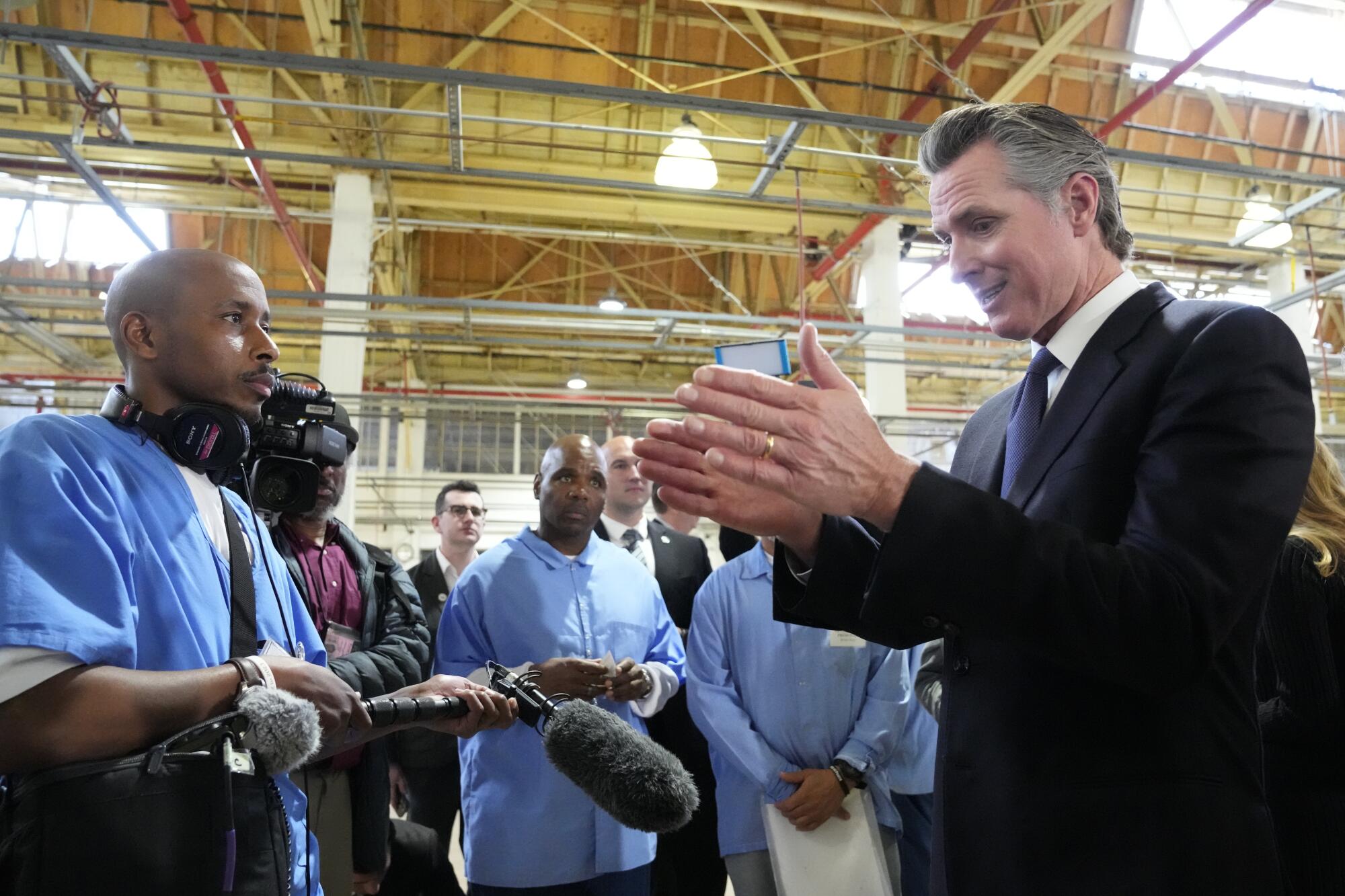
Though it’s most often thought of as a Scandinavian take on incarceration, I visited a facility recently in Pennsylvania that uses the same approach Newsom is advocating. What I found was that it was less about the services and supports offered and more about the expectations of incarceration for both prisoners and the officers who guard them. Correctional officers ate with inmates, talked about life, even played chess with them, creating a more normalized existence.
The officers did this not for the sake of the inmates, but for public safety — so that those who are incarcerated can acquire the social and practical skills to be good neighbors by the time they are released.
Because in California, 30,000 people are released from prison each year. It cannot be left to chance — to the Jill Harrisons, the volunteers, the mishmash of classes, therapies and trainings currently offered in our prisons — to Frankenstein rehabilitation on to a system designed for punishment. Remember, it has been only about 20 years since the California Department of Corrections tacked “and Rehabilitation” on to its name and began to reform itself.
But that effort lacks consistency and coherence. There is no overarching philosophy or framework that lays out a path. Every Cainen Chambers is left to patch together what they can, and every Jill Harrison is left praying they do.
In the recently approved state budget, legislators begrudgingly gave Newsom $360 million to rebuild parts of San Quentin as a flagship facility for this new model of intensive rehabilitation, and an additional $20 million to lay out that plan in detail by the end of this year.
Sacramento Mayor Darrell Steinberg, who is leading the San Quentin Transformation Advisory Council, calls it “a generational opportunity to improve public safety,” and he’s right.
But it’s one with an expiration date. If the change at San Quentin is not completed before Newsom leaves office in 2027, there’s a real chance it never happens, because not many politicians want to risk their political and financial capital on prison reform. In fact, getting that money from legislators was a huge fight in no small part because few people understand what Newsom is talking about.
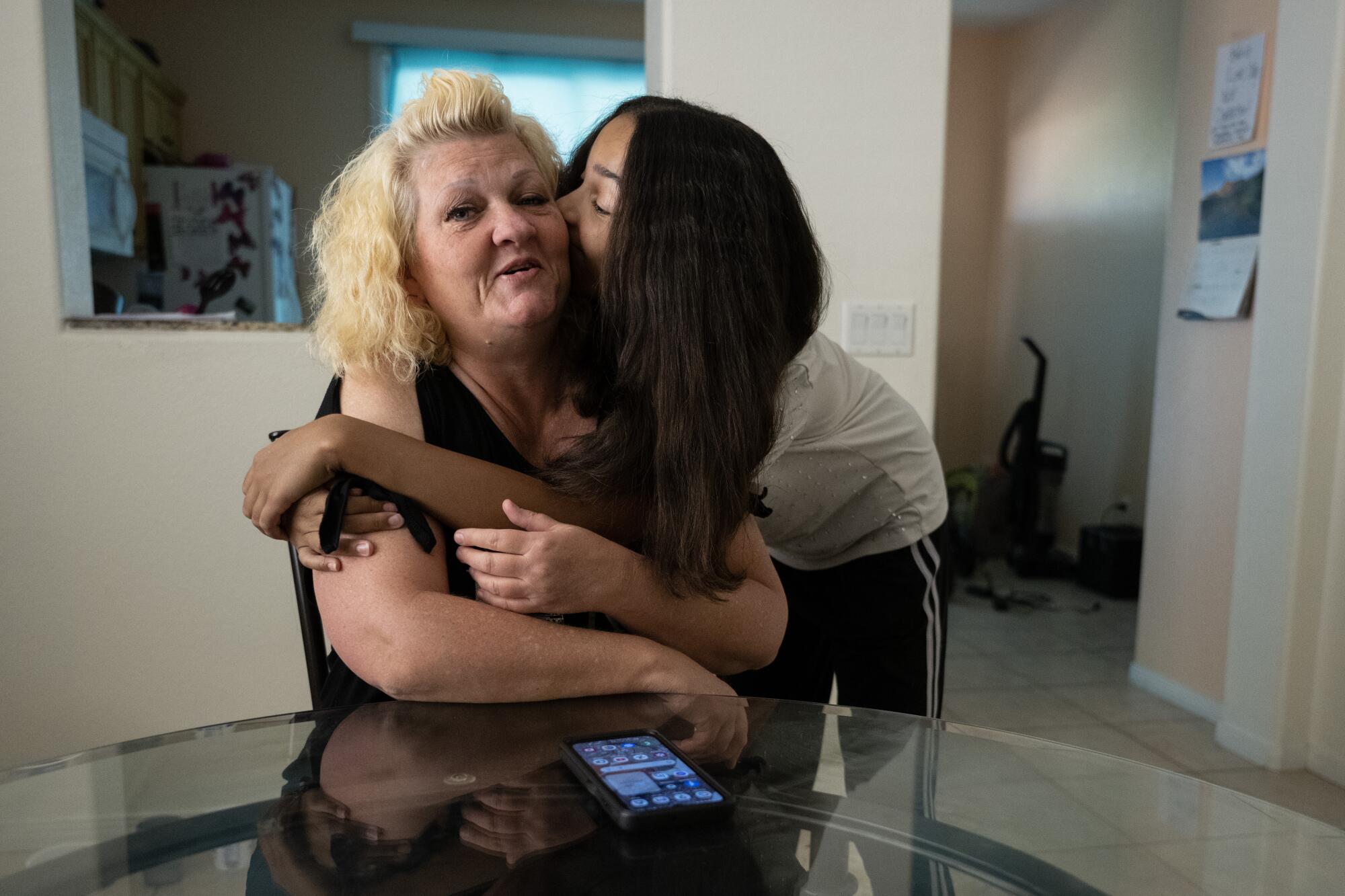
Though this transition to a new model of incarceration comes heavily supported by both research and real-world experience, to the average person, it sounds as though we are building a summer camp for killers — never a popular starting point with voters or politicians.
Harrison is not naive. She knows there are psychopaths and sociopaths who may never be safe in society. She knows there are men (yes, it is predominately men who commit violent crime) who don’t want to change.
But she also knows, with the pain of losing a child, that what we do now is a failure. She knows that time and again, California prisons are releasing people for whom the past owns the future.
That, she cannot forgive. And neither should we.
- Share via
Watch L.A. Times Today at 7 p.m. on Spectrum News 1 on Channel 1 or live stream on the Spectrum News App. Palos Verdes Peninsula and Orange County viewers can watch on Cox Systems on channel 99.
More to Read
Sign up for This Evening's Big Stories
Catch up on the day with the 7 biggest L.A. Times stories in your inbox every weekday evening.
You may occasionally receive promotional content from the Los Angeles Times.
